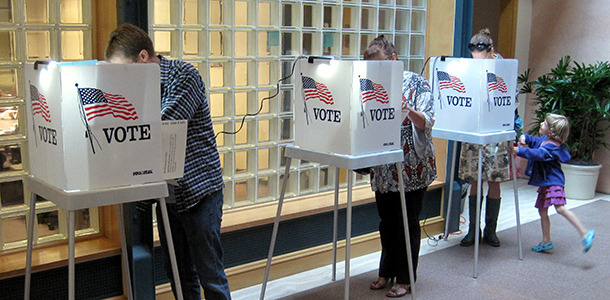
(Photo Credit: Danny Howard/Flickr)
How do we modernize elections and expand participation in California’s democracy? It’s a complex question that has no single answer.
The Future of California Elections (FoCE) Conference this week in Los Angeles will address that question in what organizers say will allow election stakeholders to work toward a collective effort to improve how we fund and hold elections.
One panel titled The Future of Sustainable Election Funding and Governance features a number of experts who will explore the true cost of elections and strategies for providing adequate and sustainable funding for elections in California.
“Election administrators face rising costs and significant barriers, including updating voting systems,” said Kim Alexander, president of the California Voter Foundation. “To expand participation in California’s democracy we need to do a better job of paying for elections, which our panel will discuss.”
Alexander will be joined by other elections experts at the event which will be held at the California Endowment on Thursday February 25.
- Cathy Darling Allen, County Clerk/Registrar of Voters, Shasta County
- Caitlin Maple, Research Analyst, California Forward
- Pamela Smith, President, Verified Voting
- Moderator: Ofelia Medina, Director of State Civic Engagement Policy, NALEO Educational Fund
With the question of funding on many minds, California Forward (CA Fwd), a member of FoCE, has been conducting surveys of election officials to explore ways to more sustainably fund election administration. The Election Funding Project has set out to discover how elections are funded in California and other states in order to create a ‘menu of options’ for state and local governments to finance elections.
“We found that counties believe funding is inadequate for new laws and regulations, complying with mandates, purchasing voting systems and conducting special elections,” said Caitlin Maple, research analyst for CA Fwd. “It is imperative that the state and counties find adequate, reliable and equitable funding solutions for elections so we don’t find ourselves having the same conversations a decade from now.”
After assessing survey data and feedback along with conducting regional meetings with registrars, here are common themes unearthed by CA Fwd:
- Technology is consistently antiquated and hard to update – locking in higher costs
- The certification and procurement processes limit the use of technology as a way to reduce and control costs
- There is a stalemate on the “fair share” of election costs which continues the historic state-local tension and prevents improvements to the process
- Minimal cooperation among the counties to reduce costs
- Little incentive for continuous improvement and cost-savings at the local level
What does a solution look like?
“The process begins by asking the right questions including: what do we want elections to look like?” Maple said. “For us, this means creating a pathway to modernization that includes using technology to be efficient and effective, repairing relationships between the state and local governments and creating incentives for counties to continually improve.”
After compiling the feedback from surveys and meetings with registrars, CA Fwd has some insight on potential improvements. Those suggestions include:
- Updating certification and procurement processes to accommodate new technology
- Anticipating and incorporating technology options
- Develop a funding mechanism with the right incentives
- Determining the “fair share” of election costs, such as State funding for special elections, statewide offices and ballot measures
- Creating incentives for efficiency, cooperation and continuous improvement
Exploring how technology can be useful, structuring state contributions to get the right results and encouraging California’s 58 counties to work together in continuous improvement can make the election dollars go further and improve how and where we vote.
It’s a step toward improving voter participation, a step that will be discussed this week.

